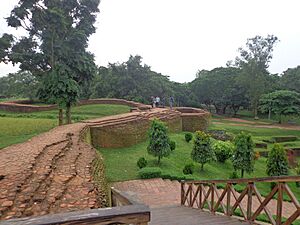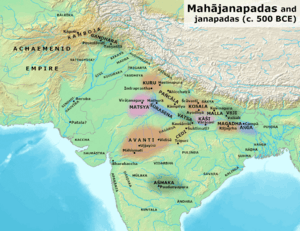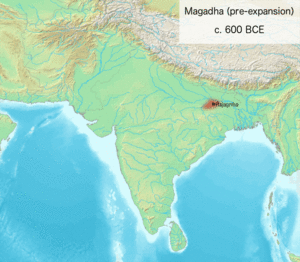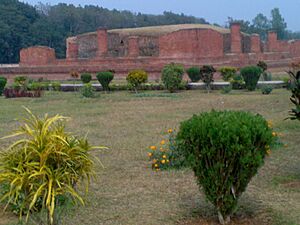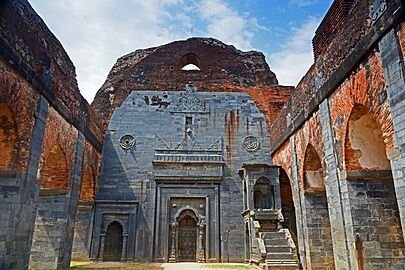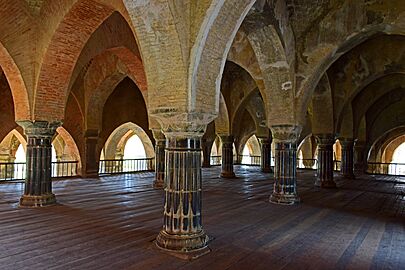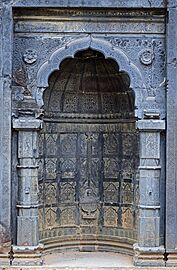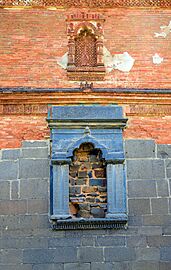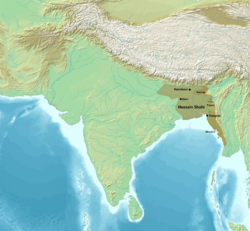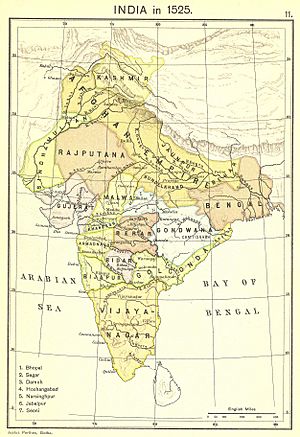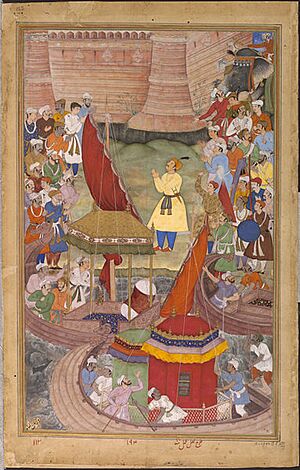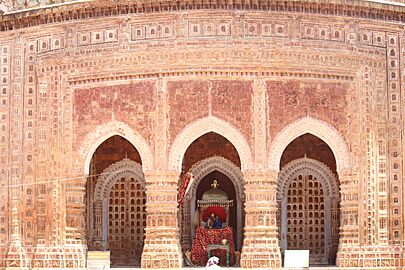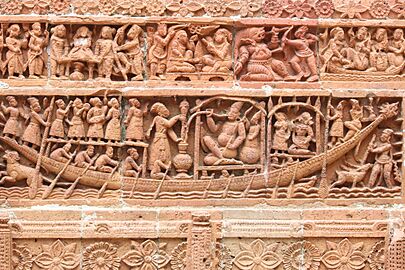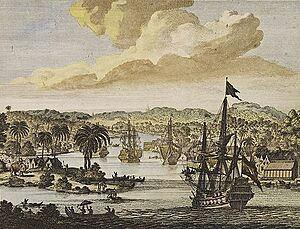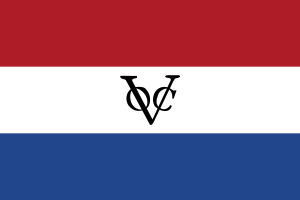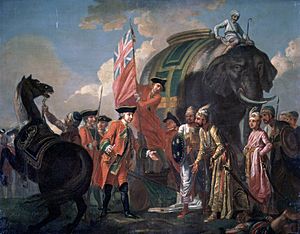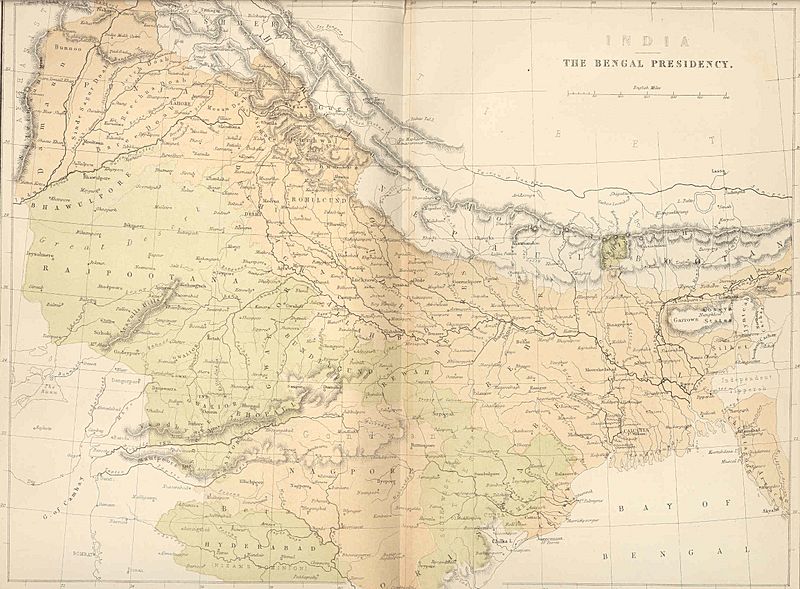History of Bengal facts for kids
The history of Bengal is a long and exciting story, connected to the history of the wider Indian subcontinent and nearby parts of South Asia and Southeast Asia. Today, Bengal includes Bangladesh and the Indian states of West Bengal, Tripura, and part of Assam. This area is in eastern India, near the Bay of Bengal, and is famous for the very fertile Ganges delta.
Long ago, the ancient Greeks and Romans knew this region as Gangaridai. It was a powerful kingdom with many war elephants. In fact, its strong army made Alexander the Great decide not to invade further into India! Some historians think Gangaridai might have been in other parts of India too. The Ganges River and the Brahmaputra River are like natural borders for Bengal, but they also connect it to the rest of India. Bengal has often played a very important role in the history of the Indian subcontinent.
In its early days, Bengal saw many different empires rise and fall. There were also fights between Hinduism and Buddhism for control. Ancient Bengal had several big kingdoms called Janapadas, and its first cities appeared around the time of the Vedic period. Bengal was a major trading hub, connected to the ancient Silk Road. It traded a lot with Persia, Arabia, and the Mediterranean, especially for its valuable cotton muslin cloth. Big empires like the Mauryans and Guptas ruled parts of Bengal. It also had its own strong local kingdoms. The city of Gauda was the capital for several of these, including the Buddhist Pala Empire (from the 700s to 1100s) and the Hindu Sena Empire (from the 1100s to 1200s). During these times, the Bengali language, its script, literature, music, art, and architecture all grew and developed.
Later, the Muslim conquest of the Indian subcontinent brought Bengal into the world of Islamic and Persian cultures. From 1204 to 1352, Bengal was a province of the Delhi Sultanate. This is when the taka currency was first used, which is still used today. In 1346, an independent Bengal Sultanate was formed, ruling for two centuries. During this time, Islam became the official religion. The rulers also made Bengal a center of Indo-Persian culture in the east. The Sultans even influenced the Arakan region in Southeast Asia, where Buddhist kings copied their government, money, and fashion. Bengal also had a good relationship with Ming China during the Sultanate period.
The Bengal Sultanate was special because it had many Hindu nobles. For example, Raja Ganesha and his son Jalaluddin Muhammad Shah even took over as rulers. Hindus worked in the royal government as prime ministers and poets. With the support of Sultans like Alauddin Hussain Shah, Bengali literature started to become more popular than Sanskrit in the region. There were also Hindu kingdoms like Mallabhum, Bhurshut, and Kingdom of Tripura, and powerful Hindu Rajas like Pratapaditya and Raja Sitaram Ray.
After the Sultanate declined, Bengal became part of the Mughal Empire. It was the richest province of the Mughals. Under Mughal rule, Bengal Subah became famous worldwide for its industries, especially textile manufacturing and shipbuilding. In the 1700s, Bengal's economy was bigger than any of Europe's empires! This growth was like an early form of the Industrial Revolution. Bengal's capital, Dhaka, was said to have over a million people.
As the Mughal Empire slowly weakened, Bengal became semi-independent under local rulers called the Nawabs of Bengal. This happened after the Maratha invasions of Bengal. Finally, the British East India Company took control.
The East India Company took over Bengal in the late 1700s. They secured their power after winning the Battle of Plassey in 1757 and the Battle of Buxar in 1764. By 1793, they had full control. The money the East India Company made in Bengal was used to fund industries like textile manufacturing in Great Britain during the start of the Industrial Revolution. However, the Company's rules also caused Bengal's own textile industry to decline. Kolkata (or Calcutta) was the capital of British India for many years. Because Bengal was exposed to British rule for a long time, Western-style education grew, leading to advancements in science, formal education, and social changes. This period is known as the Bengali Renaissance. Bengal was a key place for the Indian independence movement in the early 1900s. In 1947, when India became independent, Bengal was divided based on religion. It became West Bengal, a state in India, and East Bengal, which was part of the new country of Dominion of Pakistan. East Bengal later became the independent nation of Bangladesh in 1971.
Contents
- What's in a Name?
- Early History
- Classical Bengal
- Medieval and Early Modern Bengal
- European Settlements in Bengal
- After Partition
- See also
What's in a Name?
The exact origin of the word Bangla is not fully known. Some believe it comes from a tribe called Bang/Banga who spoke a Dravidian language and settled in the area around 1000 BCE. Others think it comes from Venga (Bôngo), which might be from an Austric word "Bonga" meaning Sun-god.
Ancient Indian texts like the Mahabharata say that Vanga was a kingdom founded by a son of King Vali. The earliest mention of "Vangala" (Bangala) is from 805 CE, referring to the king of Bengal. In the 11th century, a king from the Chola dynasty used the term Vangaladesa.
The name Bangalah was widely used for Bengal during the medieval and early modern times. The Sultan of Bengal was called the Shah of Bangalah. The Mughal province of Bengal was known as Subah-i-Bangalah.
A writer named Abu'l-Fazl had an interesting idea about the name in his book Ain-i-Akbari. He said the original name was "Bung." The "al" part was added because ancient kings built earth mounds, 10 feet high and 20 feet wide, in low areas near hills. These mounds were called "al." So, "Bung" plus "al" became "Bengal."
Early History
Tools from the Stone Age found in Bengal show that people have lived here for over 20,000 years. Remains of Copper Age homes, including pit dwellings, are 4,000 years old. Over time, different groups of people settled in Bengal, including Austroasiatics, Tibeto-Burmans, Dravidians, and Indo-Aryans.
Archaeological finds confirm that by 2000 BCE, people in the Bengal delta were growing rice, living in organized villages, and making pottery. Rivers like the Ganges and Brahmaputra were used for travel, and sea trade was active in the Bay of Bengal.
The Iron Age
During the Iron Age, people started using coins, metal weapons, and improved farming methods with irrigation. Large cities appeared around 500 BCE. The archaeological site of Mahasthangarh is believed to be the capital of the Pundra Kingdom, mentioned in ancient texts.
Ancient Stories and Maps
Ancient Bengal is often mentioned in old stories from India, Sri Lanka, and Southeast Asia. The Indian epic Mahabharata describes the Vanga Kingdom in Bengal as a sea-faring power with colonies in Southeast Asia. Sri Lankan history says that the first king of Sri Lanka, Prince Vijaya, sailed from India to conquer the island, and his family came from Bengal.
In the Greco-Roman world, historians believe that stories about the Gangaridai Kingdom referred to Bengal. When Alexander the Great invaded India, the combined strength of Gangaridai and the Nanda Empire (in Bihar) made the Greek army turn back. The Gangaridai army was said to have 6,000 war elephants! Ancient sites like Wari-Bateshwar and Chandraketugarh are linked to the Gangaridai kingdom.
In Ptolemy's world map, a major trading port called Sounagoura (Sonargaon) was located in Bengal. Roman geographers also noted a large natural harbour in southeastern Bengal, which is likely the Chittagong region today.
Bengal in Ancient Times
Ancient Bengal was often divided into different kingdoms during the Vedic Period. Sometimes, the region was united under one ruler, and at other times, it was part of larger Indian empires.
Bengal Under Big Empires
Bengal was often ruled by powerful empires from the Magadha region.
- Nanda Empire (around 345 – 322 BCE): The Nanda Empire, led by Mahapadma Nanda, grew very large. It stretched from Punjab in the west to Odisha and Bengal in the east.
- Maurya Empire (around 322 – 185 BCE): The Mauryan Empire was one of the biggest empires in Indian history, uniting most of the subcontinent for the first time. It brought a single system for money, government, and safety. Under Emperor Ashoka, there was peace, religious change (Buddhism spread), and growth in science and knowledge. The Mauryans built the Grand Trunk Road, a very old and long road connecting India with Central Asia.
- Shunga and Kanva Dynasties (around 185 – 28 BCE): After the Mauryans, Bengal was often ruled by dynasties from Magadha, like the Shunga dynasty and Kanva dynasty.
Classical Bengal
Gupta Empire
The Gupta Empire is often called a golden age in Indian history. It was a time of great scientific and cultural progress, which shaped what we know as Hindu culture. The Hindu number system, which uses place values (like our numbers 0-9), started during Gupta rule. The peace and wealth under the Guptas allowed people to focus on science and art.
Bengal was an important part of the Gupta Empire. Many Gupta-era coins found in Bengal show that money was widely used for trade.
Gauda Kingdom
King Shashanka is seen by some as the first king to unite Bengal. He set up his kingdom in the city of Gauda, ruling from about 590 to 625 CE. The Bengali calendar is thought to have started during his reign.
Pala Empire
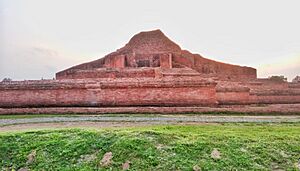
The Pala Empire (750–1120 CE) was a Bengali empire and the last major Buddhist power in India. The Palas followed the Mahayana and Vajrayana types of Buddhism. Gopala I became the first ruler in 750 CE, chosen by local leaders. He united Bengal under his rule.
The Pala dynasty lasted for four centuries, bringing stability and wealth to Bengal. They built many temples and artworks. They also supported important learning centers like Nalanda and Vikramashila. The Somapura Mahavihara, built by Emperor Dharmapala, was the largest Buddhist monastery in India.
The empire was strongest under Emperor Dharmapala (770–810) and Devapala (810–850). Dharmapala expanded the empire into northern India. Devapala's records say he defeated many kingdoms, showing the Palas' power.
Chandra Dynasty
The Chandra dynasty ruled southeastern Bengal and Arakan from the 900s to 1000s CE. They were strong enough to resist the Pala Empire. Their kingdom was a link between India and Southeast Asia. During this time, the port of Chittagong became a center for banking and shipping. The last Chandra ruler, Govindachandra, was defeated by a South Indian emperor in the 11th century.
Sena Empire
The Pala dynasty was replaced by the Hindu Sena dynasty, who came from South India. Unlike the Palas who supported Buddhism, the Senas were strong Hindus. They helped Hinduism grow again and encouraged Sanskrit literature in eastern India. They united Bengal under one ruler in the 12th century.
Vijaya Sena, the second Sena ruler, defeated the last Pala emperor and officially started his rule. Ballala Sena, the third ruler, was a wise king who invited Brahmins (Hindu priests) from other parts of India to settle in Bengal and help Hinduism revive. He expanded his kingdom to cover almost all of Bengal and parts of Assam. Ballala Sena made Nabadwip his capital.
The fourth Sena king, Lakshmana Sena, was the greatest of his family. He expanded the empire beyond Bengal into Bihar, Assam, Odisha, and possibly Varanasi. Lakshmana was later defeated by Turkic Muslims and fled to eastern Bengal, where he ruled for a few more years. Some believe that Jayadeva, the famous Sanskrit poet, was one of the "five Gems" in Lakshmana Sena's court.
Deva Dynasty
The Deva dynasty was a Hindu dynasty in medieval Bengal that ruled eastern Bengal after the Sena Empire fell. Their capital was Bikrampur in modern-day Bangladesh. Records show their kingdom reached the Comilla–Noakhali–Chittagong region. A later ruler, Dasharatha-Deva, expanded the kingdom to cover much of East Bengal. The Deva dynasty lasted even after Muslim conquests but eventually ended.
Medieval and Early Modern Bengal
Delhi Sultanate (1204–1352)
The Islamic conquest of Bengal began when Bakhtiar Khilji, leading an army of horsemen, captured Gauda from the Sena dynasty in 1204. The Delhi Sultanate kept a close watch on Bengal. Several governors tried to become independent, but the Delhi Sultanate stopped them for a century. By the 1300s, eastern Bengal also came under Muslim rule, for example, through the Conquest of Sylhet. Sufi holy men helped spread Islam in Bengal. During the Tughluq dynasty, the taka was introduced as the official currency.
Small Sultanates (1338–1352)
In the mid-1300s, three small sultanates broke away from the Delhi Sultanate in Bengal. These were led by Fakhruddin Mubarak Shah in Sonargaon, Alauddin Ali Shah in Gauda, and Shamsuddin Ilyas Shah in Satgaon. The famous traveler Ibn Battuta visited Sonargaon during this time and also met the Sufi leader Shah Jalal in Sylhet.
Bengal Sultanate (1352–1576)
- Adina Mosque
Ilyas Shahi Dynasty (1342–1414 and 1435–1487)
In 1352, Shamsuddin Ilyas Shah united the three small sultanates into one government. He called himself the "Shah of Bangalah." His son, Sikandar Shah, defeated the Sultan of Delhi, making Bengal a truly independent kingdom. The largest mosque in India was built in Bengal to show the new sultanate's power. The sultans improved public services and became more connected to local culture. Many impressive buildings were constructed, showing influences from Persian, Arab, and Byzantine architecture. This dynasty promoted Indo-Persian culture. One sultan, Ghiyasuddin Azam Shah, even wrote letters to the famous Persian poet Hafez.
The early Bengal Sultanate had strong diplomatic ties. They sent ambassadors to Ming China during the reign of Emperor Yongle. China sent its own envoys, including those on the famous Treasure voyages, and helped settle regional disputes. There are also records of the sultans' relationships with Egypt, Herat, and some African kingdoms.
The Ilyas Shahi Dynasty was briefly interrupted in 1414 by a local uprising but was brought back by Nasiruddin Mahmud Shah in 1433.
Hindu-Muslim Rulers (1414–1435)
The Ilyas Shahi rule was stopped by an uprising led by the sultan's chief minister, Raja Ganesha, a Hindu noble. Ganesha put his son Jadu on the throne, but Jadu was persuaded by the court's Sufi religious leaders to convert to Islam. Jadu took the name Jalaluddin Muhammad Shah. During his rule, local Bengali culture was promoted in the court. Bengali influences were added to the kingdom's architecture. A war between the Bengal Sultanate and the Jaunpur Sultanate ended after China and the Timurids helped mediate. Jalaluddin Muhammad Shah also helped the king of Arakan get his throne back after Burmese forces had removed him.
Hussain Shahi Dynasty (1494–1538)
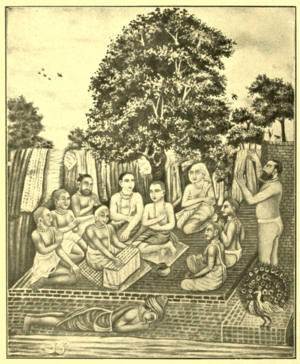
The Bengal Sultanate reached its largest size under Alauddin Hussain Shah, who started the Hussain Shahi dynasty. Many historians see this dynasty as a golden age where a mixed Bengali culture developed, combining Muslim and Hindu traditions. For example, the Muslim sultan encouraged the translation of Sanskrit epics like the Ramayana into the Bengali language. The support for Bengali literature under this dynasty led to Bengali becoming more important than Sanskrit in the region.
Other Rulers (1539–1576)
In the 1500s, the Mughal emperor Humayun had to flee to Persia because the conqueror Sher Shah Suri took over much of India. Bengal came under the control of the short-lived Suri Empire. Later, an Afghan dynasty, the Karrani dynasty, became the last royal family of the Bengal Sultanate. Their capital was Sonargaon.
Baro-Bhuyans (1576–1610)
A group of twelve powerful local families, called zamindars, fought against the expanding Mughal Empire in the 1500s and 1600s. These zamindars included both Muslims and Hindus. They were led by the Bengali Muslim chief Isa Khan. The Baro-Bhuyans defeated the Mughal navy several times in Bengal's rivers. Eventually, the Mughals defeated the rebellion and brought all of Bengal under their control.
Mughal Period (1574–1717)
The Mughals started taking over Bengal after the Battle of Ghaghra in 1529, led by the first Mughal emperor Babur. The second Mughal emperor Humayun even occupied the Bengali capital Gaur for six months. After the Bengal Sultanate fell in the Battle of Raj Mahal in 1576, Bengal became a Mughal province called the Bengal Subah.
Mughal Governors (1574–1727)
The Mughal viceroys in Bengal were called Subedars. The Bengal Subah was part of a large, wealthy empire and was shaped by the empire's policies of diverse government. The Mughals built the provincial capital in Dhaka in 1610, with forts, gardens, tombs, palaces, and mosques. Dhaka was also named Jahangirnagar in honor of Emperor Jahangir. Shaista Khan's conquest of Chittagong in 1666 defeated the Arakanese kingdom and brought the port city back under Bengali control. The Chittagong Hill Tracts became a tributary state of Mughal Bengal.
Members of the royal family were often appointed as Subedars. Raja Man Singh I, a Hindu Rajput ruler, was the only Hindu Subedar. Prince Shah Shuja, son of Emperor Shah Jahan, was also a Subedar. During a fight for the throne with his brothers, Prince Shuja declared himself Mughal Emperor in Bengal. He was later defeated by the army of Aurangazeb.
Nawabs of Bengal (1717–1772)
By the 1700s, Mughal Bengal became almost independent, though it still officially recognized the emperor in Delhi. The Subedar became a hereditary ruler called a Nawab Nazim. The Nawabs had real control over Bengal, even though they still minted coins in the emperor's name.
- Nasiri Dynasty (1717–1740): This dynasty was founded by the first Nawab of Bengal, Murshid Quli Khan.
- Afsar Dynasty (1740–1757): Founded by Alivardi Khan. His grandson, Siraj-ud-daulah, was the last independent Nawab of Bengal. He was defeated by British forces at the Battle of Plassey in 1757. Nawabs from the Najafi dynasty continued to rule as semi-independent rulers until 1772, when the British East India Company took full control.
Bengal's Economy Under the Mughals
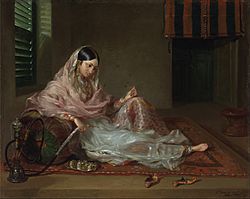
Under the Mughal Empire, Bengal was a very rich province with a Muslim majority and Hindu minority. Historians say it was famous worldwide for industries like textile manufacturing and shipbuilding. The capital, Dhaka, had over a million people and about 80,000 skilled textile weavers. Bengal exported silk and cotton textiles, steel, saltpetre, and farm products.
Bengali farmers quickly learned to grow profitable new crops between 1600 and 1650. They learned how to cultivate mulberry and raise silkworms, making Bengal a major silk-producing region.
Bengal was a global center for the muslin and silk trades. Dhaka was the most important cotton production center, which is why muslin was called "daka" in distant markets. Within India, many regions relied on Bengali products like rice, silks, and cotton textiles. Overseas, Europeans depended on Bengali products like cotton textiles, silks, and opium. For example, Bengal made up 40% of Dutch imports from Asia. Saltpetre was shipped to Europe, opium to Indonesia, raw silk to Japan and the Netherlands, and cotton and silk textiles to Europe, Indonesia, and Japan.
Bengal also had a large shipbuilding industry. Some estimates suggest Bengal built 223,250 tons of ships annually in the 16th and 17th centuries, much more than the 23,061 tons built in North America's thirteen colonies from 1769 to 1771.
Hindu States
- Kantajew Temple
Several Hindu states existed in and around Bengal during the medieval and early modern periods. These kingdoms greatly added to Bengal's economy and culture. They reclaimed land from forests and swamps, and encouraged trade. They also brought new music, painting, dancing, and sculpture to Bengali art, and built many temples. Militarily, they helped protect against Portuguese and Burmese attacks.
These states included the kingdoms of Maharaja Pratapaditya of Jessore, Raja Sitaram Ray of Burdwan, Raja Krishnachandra Roy of Nadia Raj, and Kingdom of Mallabhum. The Kingdom of Bhurshut was a medieval Hindu kingdom in what is now Howrah and Hooghly. Maharaja Rudranarayan made this kingdom very powerful. His wife, Maharani Bhavashankari, defeated the Pathans in Bengal, bringing power and wealth to the kingdom. Their son, Maharaja Pratapnarayan, supported literature, art, trade, and the well-being of his people. Later, Maharaja Naranarayan kept the kingdom independent by cleverly avoiding Mughal occupation. The Koch Bihar Kingdom in northern Bengal also thrived in the 16th and 17th centuries, surviving Mughal challenges until the British arrived. The Bardhaman Raj was a large landholding that flourished from 1657 to 1955, first under the Mughals and then the British.
Immigration
Bengal welcomed many immigrants from West Asia, Central Asia, Africa, and North India during the sultanate and Mughal periods. Many came as refugees from the Mongol invasions and conquests. Others found Bengal's fertile land good for farming and trade. Arabs were among the first settlers, especially in coastal areas. Persians settled in Bengal as religious leaders, teachers, soldiers, and poets. An Armenian community from the Safavid Empire also moved to the region. There were many Turkic immigrants too. The Portuguese were the first Europeans to settle in Bengal.
Many Arakanese fled persecution in Burma and settled in southern Bengal in the 1700s. Many Manipuris settled in eastern Bengal in the 1700s, escaping conflicts in Assam. The Marwari community, who came from Rajasthan, is still important in West Bengal's economy. In Bangladesh, a Nizari Ismaili community also plays a big role in the economy.
Maratha Invasions
After Murshid Quli Khan, the governor of Bengal, Orissa, and Bihar, died in 1727, Raghuji Bhonsle, a general from the Maratha Empire, took advantage of the chaos. He invaded Bengal and took over Orissa.
During their raids, the Marathas killed almost 400,000 people in western Bengal and Bihar. This severely damaged Bengal's economy, as many of those killed were merchants, textile weavers, and farmers. For example, a report from 1742 said that the Marathas burned down many houses and weavers' looms. These attacks are considered some of the deadliest massacres in Indian history.
European Settlements in Bengal
Portuguese Chittagong (1528–1666)
The first European settlement in Bengal was the Portuguese settlement in Chittagong. The Bengal Sultanate allowed them to set up a trading post. Portuguese settlers in Chittagong included merchants, soldiers, sailors, missionaries, slave traders, and pirates. They controlled the port of Chittagong and made all merchant ships get a Portuguese trade license. The Roman Catholic Church was established in Bengal by the Portuguese in Chittagong.
The Portuguese later came under the protection of the Kingdom of Mrauk U as the Bengal Sultanate lost control of Chittagong. In 1666, the Mughal conquest of Chittagong expelled the Portuguese and Arakanese. The Portuguese also moved to other parts of Bengal, like Bandel and Dhaka.
The Portuguese brought new fruits, flowers, and plants to Bengal, which quickly became part of local life. These included potatoes, cashew nuts, chillies, papayas, pineapples, Carambolas, guavas, and tomatoes. They also brought the Krishna Kali flower. The Portuguese married local women, and many Portuguese words like janala (window), almari (cupboard), and chabi (key) entered the Bengali language. They were also very interested in the Bengali language. The first printed book in Bengali prose, and the first Bengali grammar and dictionary, were written by a Portuguese man named Manuel da Assumpção. This helped standardize and print the Bengali language, slowly reducing the influence of Persian. Even today, many Bangladeshi Christians have Portuguese last names.
Dutch Settlements (1610–1824)
The Dutch East India Company had a trading office in Bengal for almost two centuries. This office later became a colony of the Dutch Empire in 1725. Dutch territories in Bengal were given to Britain in 1824. Dutch settlements included a main port in Baliapal and factories in places like Dhaka (for muslin) and Cossimbazar.
Bengal once provided 40% of Dutch imports from Asia, especially silk and muslin goods.
Early English Settlements (1600s)
The East India Company first settled in Bengal around Hooghly in the 1630s. They got official permission to trade from the Mughal viceroy Shah Shuja in 1651. In 1689, the company tried to take Chittagong, but it was too well defended. In 1696, the English built Fort William on the Hooghly River. Fort William became the main British base in India for centuries. The area around it grew into the city of Calcutta. English factories were set up all over Bengal. The port at Fort William became a very important British naval base in Asia, from where expeditions were sent to China and Southeast Asia. The English language began to be used for business and government in Bengal.
French Settlements (1692–1952)
The French also had colonies and factories in Bengal. After getting permission from Mughal viceroy Shaista Khan in 1692, the French set up a settlement in Chandernagore. The French also had a big presence in Dhaka, where a neighborhood called Farashganj developed. The French also owned the land where the Ahsan Manzil stands today. They built a garden in Tejgaon.
The French supported Nawab Siraj-ud-Daulah during the Battle of Plassey in 1757. Eventually, the French presence in Bengal was limited to Chandernagore. After India's independence in 1947, Chandernagore voted to end colonial rule. The French handed over control in 1952, and in 1955, Chandernagore became part of the Indian state of West Bengal.
Danish Settlements (1625–1845)
The first settlement of the Danish East India Company in Bengal was in Pipli in 1625. The Danish later got permission from Nawab Alivardi Khan to set up a trading post in Serampore in 1755. This town was named Fredericknagore. The Danish also had colonies on the Nicobar Islands in the Bay of Bengal. These territories were part of Danish India until 1845, when they were given to Britain.
Austrian Settlement (1700s)
The Ostend Company from the Austrian Empire had a settlement in Bankipur, Bengal, during the 1700s.
British East India Company (1772–1858)
When the East India Company started making Fort William (Calcutta) stronger, the Nawab, Siraj Ud Daulah, attacked them, encouraged by the French. Led by Robert Clive, British troops and their local allies captured Chandernagore in March 1757. They then severely defeated the Nawab on June 23, 1757, at the Battle of Plassey, because the Nawab's soldiers betrayed him. The Nawab was killed in Murshidabad, and the British put their own Nawab in charge of Bengal and took direct control of the south. Chandernagore was returned to the French in 1763.
The Bengalis tried to get their lands back in 1765, allied with the Mughal Emperor Shah Alam II, but they were defeated again at the Battle of Buxar (1765). As part of the treaty, the East India Company got the right to collect taxes from the province. So, the company became the tax collector, while the local Mughal-appointed Nawabs continued to govern. In 1772, this arrangement ended, and the East India Company took full control of the province. Calcutta became the new center of Indian culture and trade as the Mughal Empire declined.
Money made by the East India Company in Bengal was invested in industries like textile manufacturing in Great Britain during the early stages of the Industrial Revolution. However, the Company's policies in Bengal also caused the Bengali textile industry to decline.
During the Company's rule, a terrible famine happened in 1770, killing millions of people. This famine devastated the region and also hurt the East India Company's finances, forcing them to rely on money from the British government.
British Crown Rule (1858–1947)
The Indian Rebellion of 1857 led to the British Crown taking direct control of Bengal from the East India Company. Fort William remained the capital of British-held territories in India. The Governor of Bengal was also the Governor-General of India for many years. In 1877, when Queen Victoria became "Empress of India", the British declared Calcutta the capital of the British Raj. The colonial capital grew in Calcutta, serving as the capital of India for decades. Bengal, known for growing rice and being the world's main source of jute fiber, was one of India's largest industrial centers. From the 1850s, industry was centered around Calcutta.
The railway was introduced to Bengal in 1854. Several railway companies were set up in Bengal in the 1800s, including the Eastern Bengal Railway. The largest seaport in British Bengal was the Port of Calcutta, one of the busiest ports in the British Empire. The Calcutta Stock Exchange was established in 1908. Other ports included Narayanganj, Chittagong, and Dhaka. Bengali ports were often free trade ports, welcoming ships from all over the world. There was a lot of shipping with British Burma. Two universities were established in Bengal during British rule: the University of Calcutta and the University of Dacca. Many colleges and schools were also built. However, most Bengalis still depended on farming. Despite Bengali leaders playing a big role in Indian politics and ideas, some districts remained very undeveloped.
The Bengal Presidency had the highest economic output in British India. Bengal also had the most advanced cultural centers in British India. A diverse and mixed cultural atmosphere developed. There were many people who admired English culture. A Portuguese missionary published the first book on Bengali grammar. A Hindu scholar translated the Quran into Bengali. However, Bengalis were also divided by religion due to the political situation in the rest of India.
Bengali Renaissance

The Bengal renaissance was a social reform movement in Bengal during the 1800s and early 1900s under British rule. Historian Nitish Sengupta says it began with reformer Raja Ram Mohan Roy (1775–1833) and ended with Asia's first Nobel laureate, Rabindranath Tagore (1861–1941). This period of religious and social reformers, scholars, and writers is described as "one of the most creative periods in Indian history."
Bengal Legislative Council (1862–1947)
The Bengal Legislative Council was the main lawmaking body in the province. It was created in 1861. At first, it was an advisory council with mostly European members. But over time, more native Bengalis joined in the early 1900s. In 1935, it became the upper house of the provincial parliament. The Governor of Bengal, who was also the Governor-General of India, often attended the council.
Eastern Bengal and Assam (1905–1912)
The British government said that Bengal was too big and hard to govern because it was India's most populated province. So, in 1905, Bengal was divided into a mostly Hindu west (including Bihar and Odisha) and a mostly Muslim east (including Assam). This division made Hindu-Muslim conflict stronger. Hindu Indians disagreed, saying it divided Bengal, which was united by language and history. Muslims supported it, saying it was a big step for Muslim society where they would be the majority and could freely practice their religion and culture. But because of strong Hindu protests, the British reunited East and West Bengal in 1912, and made Bihar and Orissa a separate province.
The short-lived province of Eastern Bengal and Assam encouraged a growing movement for self-determination among British-Indian Muslims. The All India Muslim League was created during a conference on education hosted by the Nawab of Dhaka in Eastern Bengal and Assam.
Rebel Activities
Bengal played a big role in the Indian independence movement (including the Pakistan movement). Revolutionary groups like Anushilan Samiti and Jugantar were very active. Many early supporters of independence and later leaders were Bengalis. Some famous freedom fighters from Bengal included Chittaranjan Das, Surendranath Banerjee, Netaji Subhas Chandra Bose, Prafulla Chaki, Bagha Jatin, Khudiram Bose, Surya Sen, Binoy–Badal–Dinesh, Sarojini Naidu, Batukeshwar Dutt, Aurobindo Ghosh, and Rashbehari Bose. Some leaders, like Netaji, did not believe that non-violent protest was the only way to gain independence. He allied with Japan to fight the British. During World War II, Netaji escaped to Germany and founded the Indian Legion, an army to fight the British. Later, he became a co-founder and leader of the Indian National Army (different from the British Indian army) that challenged British forces in India. He was also the head of a parallel government called 'The Provisional Government of Free India', supported by the Axis powers. Bengal was also a breeding ground for several important revolutionary groups. Many Bengalis died in the independence struggle, and many were sent to Cellular Jail, a feared prison in the Andaman Islands.
Bengal Legislative Assembly (1937–1947)
The Bengal Legislative Assembly was British India's largest legislature. It was created in 1935 as the lower house of the provincial parliament. Members were elected based on a "separate electorate" system, where seats were reserved for different religious, social, and professional groups. Major parties included the All India Muslim League, the Farmers and Tenants Party, and the Indian National Congress. The Prime Minister of Bengal was a member of this assembly.
Second World War
Bengal was used as a base for Allied Forces during World War II. Bengal was important for the Burma Campaign and for helping the Republic of China fight off the Japanese invasions. The Imperial Japanese Air Force bombed Chittagong in April and May 1942, and Calcutta in December 1942. The Japanese canceled a planned invasion of Bengal from Burma. The Ledo Road was built between Bengal and China through Allied-controlled areas in northern Burma to supply the forces led by Chiang Kai Shek. Units of the United States Armed Forces were stationed at Chittagong Airfield during the Burma Campaign 1944-1945. Allied forces included troops from Britain, India, Australia, and New Zealand.
The Bengal famine of 1943 happened during World War II and caused the death of an estimated 2.1–3 million people.
Partition of Bengal (1947)
The partition of Bengal in 1947 had a huge impact on the people. The breakdown of Hindu-Muslim unity led the All India Muslim League to demand the partition of India, asking for Bengal to be part of a Muslim-majority homeland. Hindu nationalists in Bengal wanted Hindu-majority districts to be part of India. Most members of the Bengal Legislative Assembly voted to keep Bengal united. The Prime Minister of Bengal, supported by Hindu and Muslim politicians, suggested a United Bengal as a sovereign state. However, the Indian National Congress and the Hindu Mahasabha on one side, and the Muslim League on the other, forced the British viceroy Earl Mountbatten to divide Bengal based on religion. As a result, Bengal was split into the state of West Bengal in India and the province of East Bengal in Pakistan. East Bengal was renamed East Pakistan in 1955. The Sylhet region in Assam joined East Bengal after a vote on July 6, 1947.
After Partition
Indian Bengal
This refers to the history of West Bengal and Tripura after 1947.
Bangladesh
This covers the history of East Pakistan and the independent nation of Bangladesh after 1971.
See also
- List of rulers of Bengal
- Bengalis


